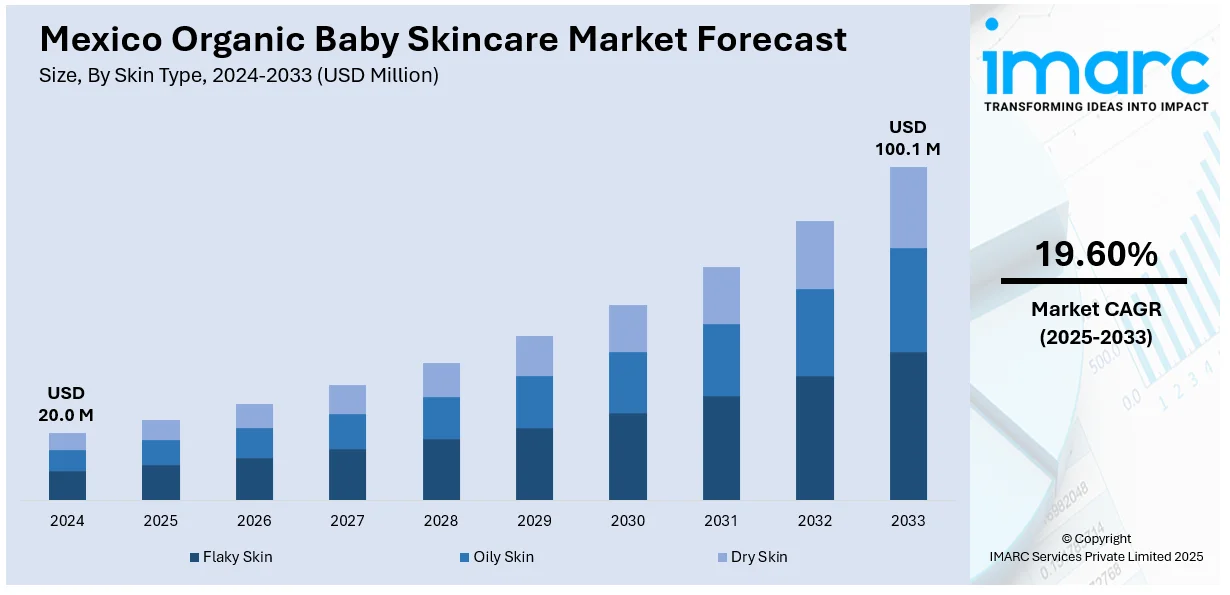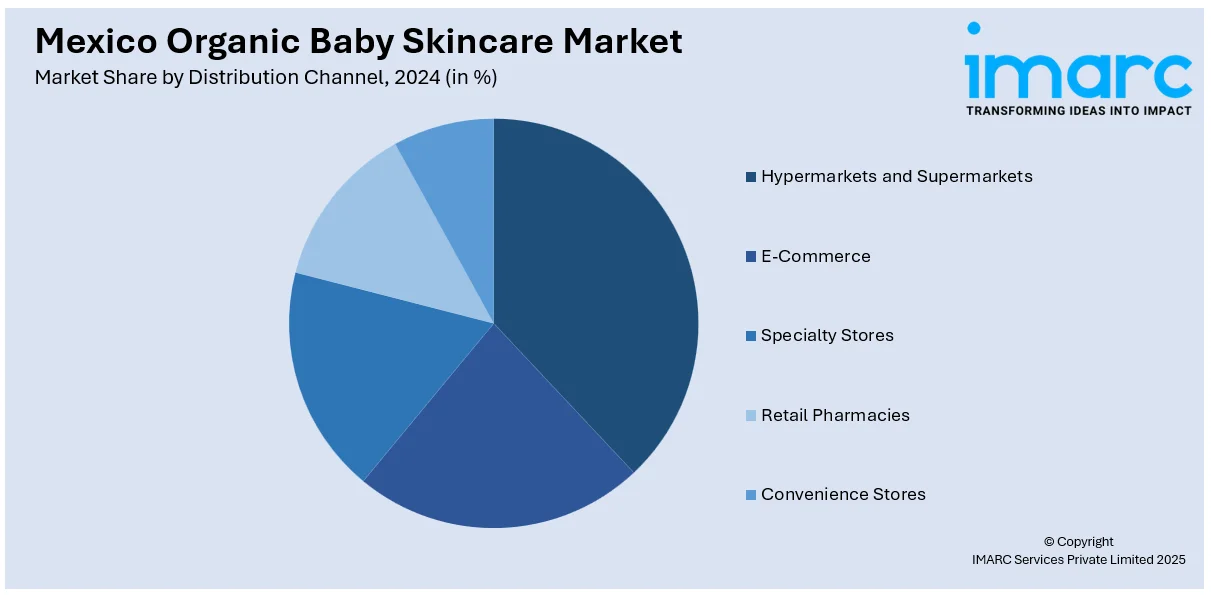
Mexico Organic Baby Skincare Market Size, Share, Trends and Forecast by Skin Type, Product Type, Distribution Channel, and Region, 2025-2033
Mexico Organic Baby Skincare Market Overview:
The Mexico organic baby skincare market size reached USD 20.0 Million in 2024. Looking forward, IMARC Group expects the market to reach USD 100.1 Million by 2033, exhibiting a growth rate (CAGR) of 19.60% during 2025-2033. The market is driven by the rising awareness among parents about the potential health hazards from the use of synthetic ingredients in baby care products, heightened sustainable and environment friendly lifestyles, and rapid expansion of distribution channels, particularly online retail platforms.
|
Report Attribute
|
Key Statistics
|
|---|---|
|
Base Year
|
2024 |
|
Forecast Years
|
2025-2033
|
|
Historical Years
|
2019-2024
|
| Market Size in 2024 | USD 20.0 Million |
| Market Forecast in 2033 | USD 100.1 Million |
| Market Growth Rate 2025-2033 | 19.60% |
Mexico Organic Baby Skincare Market Trends:
Rising Parental Awareness of Infant Health and Safety
The rising awareness among parents about the potential health hazards from the use of synthetic ingredients in baby care products is impelling the growth of the market. As more people are becoming conscious about the long-term effects of chemicals like parabens, sulfates, and artificial fragrances, there is a strong turn towards organic solutions. Organic baby skin care products are viewed as safer because they incorporate natural ingredients, fewer additives, and dermatologically tested formulas. This is also reinforced by social media, parenting websites, and health influencers, who often recommend chemical-free baby products. Furthermore, pediatricians and dermatologists are increasingly suggesting organic products to parents suffering from sensitive skin conditions like eczema, rashes, or allergies.

Growing Influence of Clean Label and Eco-Conscious Consumerism
People are increasingly embracing sustainable and environment friendly lifestyles, which, in turn, is influencing the overall purchasing habits in the industry. Organic baby skincare products tend to have clean labels that feature ingredients derived from certified organic farms, cruelty-free testing practices, and environment friendly packaging. Such openness resonates with parents who want products that are not only safe for their babies but also for the environment. Matching the organic baby care with wider principles of ethical sourcing, biodegradability, and low environmental impact is an attractive selling factor. Increasing popularity of certifying bodies also substantiates the reliability of these items in the marketplace among value-driven consumers. In 2024, during May and June, Mexico and its surrounding areas experienced excessive heat owing to climate change. With the growing awareness about climate change and environmental responsibility among millennials and Gen Z parents in Mexico, the demand for eco-friendly baby skincare products is increasing.
Expansion of Distribution Channels and E-Commerce Penetration
The Mexican organic baby skincare market is benefiting from the rapid expansion of distribution channels, particularly the growth of online retail platforms. E-commerce is greatly enhancing product availability for individuals in various regions, including rural and semi-urban areas. Online platforms provide extensive product descriptions, ingredient transparency, customer reviews, and convenient price comparisons, which are critical in shaping purchasing decisions. In addition, online channels also allow direct-to-consumer (D2C) models through which organic companies can have personal interactions with the customer and ensure brand credibility. Apart from online retail, institutional retail forms like specialty stores for babies, pharmacies, and health and well-being chains increasingly reserve shelf space for organic baby care brands. The IMARC Group predicts that the Mexico e-commerce market is expected to reach USD 176.6 Billion by 2033.
Mexico Organic Baby Skincare Market Segmentation:
IMARC Group provides an analysis of the key trends in each segment of the market, along with forecasts at the country and regional levels for 2025-2033. Our report has categorized the market based on skin type, product type, and distribution channel.
Skin Type Insights:
- Flaky Skin
- Oily Skin
- Dry Skin
The report has provided a detailed breakup and analysis of the market based on the skin type. This includes flaky skin, oily skin, and dry skin.
Product Type Insights:
- Baby Oil
- Baby Powder
- Baby Soaps
- Petroleum Jelly
- Baby Lotion
- Others
A detailed breakup and analysis of the market based on the product type have also been provided in the report. This includes baby oil, baby powder, baby soaps, petroleum jelly, baby lotion, and others.
Distribution Channel Insights:

- Hypermarkets and Supermarkets
- E-Commerce
- Specialty Stores
- Retail Pharmacies
- Convenience Stores
A detailed breakup and analysis of the market based on the distribution channel have also been provided in the report. This includes hypermarkets and supermarkets, e-commerce, specialty stores, retail pharmacies, and convenience stores.
Regional Insights:
- Northern Mexico
- Central Mexico
- Southern Mexico
- Others
The report has also provided a comprehensive analysis of all the major regional markets, which include Northern Mexico, Central Mexico, Southern Mexico, and Others.
Competitive Landscape:
The market research report has also provided a comprehensive analysis of the competitive landscape. Competitive analysis such as market structure, key player positioning, top winning strategies, competitive dashboard, and company evaluation quadrant has been covered in the report. Also, detailed profiles of all major companies have been provided.
Mexico Organic Baby Skincare Market Report Coverage:
| Report Features | Details |
|---|---|
| Base Year of the Analysis | 2024 |
| Historical Period | 2019-2024 |
| Forecast Period | 2025-2033 |
| Units | Million USD |
| Scope of the Report |
Exploration of Historical Trends and Market Outlook, Industry Catalysts and Challenges, Segment-Wise Historical and Future Market Assessment:
|
| Skin Types Covered | Flaky Skin, Oily Skin, Dry Skin |
| Product Types Covered | Baby Oil, Baby Powder, Baby Soaps, Petroleum Jelly, Baby Lotion, Others |
| Distribution Channels Covered | Hypermarkets and Supermarkets, E-Commerce, Specialty Stores, Retail Pharmacies, Convenience Stores |
| Regions Covered | Northern Mexico, Central Mexico, Southern Mexico, Others |
| Customization Scope | 10% Free Customization |
| Post-Sale Analyst Support | 10-12 Weeks |
| Delivery Format | PDF and Excel through Email (We can also provide the editable version of the report in PPT/Word format on special request) |
Key Questions Answered in This Report:
- How has the Mexico organic baby skincare market performed so far and how will it perform in the coming years?
- What is the breakup of the Mexico organic baby skincare market on the basis of skin type?
- What is the breakup of the Mexico organic baby skincare market on the basis of product type?
- What is the breakup of the Mexico organic baby skincare market on the basis of distribution channel?
- What is the breakup of the Mexico organic baby skincare market on the basis of region?
- What are the various stages in the value chain of the Mexico organic baby skincare market?
- What are the key driving factors and challenges in the Mexico organic baby skincare market?
- What is the structure of the Mexico organic baby skincare market and who are the key players?
- What is the degree of competition in the Mexico organic baby skincare market?
Key Benefits for Stakeholders:
- IMARC’s industry report offers a comprehensive quantitative analysis of various market segments, historical and current market trends, market forecasts, and dynamics of the Mexico organic baby skincare market from 2019-2033.
- The research report provides the latest information on the market drivers, challenges, and opportunities in the Mexico organic baby skincare market.
- Porter's five forces analysis assist stakeholders in assessing the impact of new entrants, competitive rivalry, supplier power, buyer power, and the threat of substitution. It helps stakeholders to analyze the level of competition within the Mexico organic baby skincare industry and its attractiveness.
- Competitive landscape allows stakeholders to understand their competitive environment and provides an insight into the current positions of key players in the market.
Need more help?
- Speak to our experienced analysts for insights on the current market scenarios.
- Include additional segments and countries to customize the report as per your requirement.
- Gain an unparalleled competitive advantage in your domain by understanding how to utilize the report and positively impacting your operations and revenue.
- For further assistance, please connect with our analysts.
 Request Customization
Request Customization
 Speak to an Analyst
Speak to an Analyst
 Request Brochure
Request Brochure
 Inquire Before Buying
Inquire Before Buying




.webp)




.webp)












